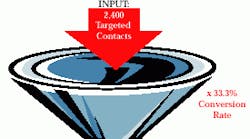It all starts with marketing. Marketing generates the leads that turn into the sales that pay the bills, and — if we have planned and executed prop-erly — that end in profit.
There are two very different aspects to the marketing process. First, there is the "right brain" or creative side, which involves the development of the actual marketing material (direct mail pieces, print ads, referral programs) that's designed to get the prospective customers' attention and motivate them to contact us. This is the aspect of marketing that we read about the most, but it's not what this article is about.
Here we'll deal with the critical, but often overlooked, "left brain" or analytical side of marketing. This involves the analysis of the pertinent data that allows us to set realistic goals and ultimately directs our marketing efforts. It allows us to accurately track our marketing results and increases the opportunity to achieve our lead generation and sales goals in a predictable, timely and profitable manner. We refer to this process as the marketing funnel.
Everything that we do in our business should be driven by our business plan, and marketing is certainly no exception. Although the marketing funnel can be used for any type of business, for this article I 'll use the example of a contracting company that's focused primarily on commercial repair, service, and replacement. This company's business plan should include the following information that's pertinent to the preparation of the marketing plan:
- Clearly-defined annual gross sales, gross profit, and net profit goals for each and every category of product and service that the company sells (replacement, repair, maintenance agreements)
- An accurate breakdown of the amount of sales expected from existing and new customers
- A seasonalized break down of the annual goals into quarterly, monthly, and weekly goals.
Once these sales goals are set, the creative marketing experts ("right brainers") need to know the target audience before any marketing pieces can be designed. That means that we must be clear as to who we want as our customers.
As our company's focus is on the commercial business segment, this narrows the scope of our marketing efforts. However, we still need to define the geographic areas in which our prospective customers are located, making sure that these customers have the profile characteristics necessary to generate the leads and sales needed to reach our targeted goals. This profile would include such information as the type, size, and age of the businesses and, if available, the age of the installed equipment.
Our next step is to gather certain historic internal company information that will further support and direct our marketing efforts. This will include sales levels, average sales ticket amounts, conversion rates, and closing rates. Using our commercial company example, Table 1 shows the type of historic information that we need in order to complete a meaningful marketing plan. (Please don't focus on whether or not you believe the numbers to be too high or too low. I am using numbers that allow simple math, so focus on the process — not the numbers).
This information can then be used to establish the ultimate goals as well as the interim objectives necessary to achieve those goals. Let's use a 10% increase to $2 million for our replacement sales goal. We would use the same process for each sales area of our business.
Using this sales goal, and applying our historic sales data, we now have identified the critical factors that will guide and measure our lead generation and sales efforts, as shown in Table 2.
Using the marketing funnel, we can visualize our goals and critical factors, and be prepared to track the results of our marketing and sales efforts.
Since the time it takes to move from targeted contacts to qualified leads to sales is typically extended over several months (according to our historic information), the marketing funnel, and its corresponding results, should also reflect these projected time periods (in this case, one year to reach our $2 million sales goal).
Our task now is to track the results of each of the critical factors in our marketing funnel. If we meet each of these critical factors, then we can be assured of meeting our targeted sales. In addition, in order to provide us with ample time to correct any negative deviations in our sales results, we must track the results on a weekly, monthly, and quarterly basis against these goals, as shown in Table 3.
Now, we can report this marketing and sales information directly on our financial statements, as shown in Table 4.
The marketing funnel is a visible, goal-oriented, and simple tool that breaks down our marketing and sales goals into more manageable, bite size steps. Try it it really works.
Al Roach is a General Partner in Callahan/Roach & Garofalo, Inc. (CRG), a leading national training and consulting firm focused primarily on the contracting industry. For more information on the marketing funnel or any other areas of managing a successful contracting business, contact CRG at 800/462- 8217.












